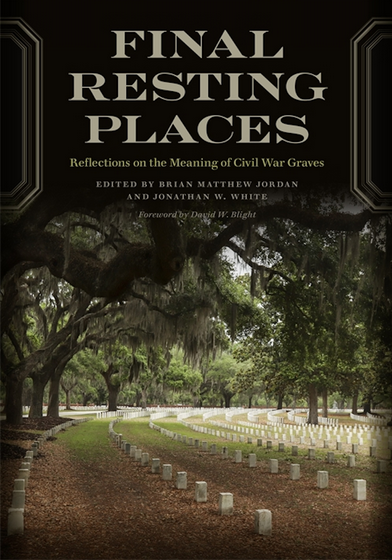Final Resting Places: Reflections on the Meaning of Civil War Graves
- Edited by Brian Matthew Jordan and Jonathan W. White
- University of Georgia Press
- 384 pp.
- Reviewed by Drew Gallagher
- October 23, 2023
A stirring compendium on why we honor our fallen.

Lewis Brownmiller has been lost to history. A distant relative of mine, Brownmiller was one of five sons who fought for the Union in the Civil War and one of three who didn’t make it back home to Ohio afterward. Online records list him as “Missing and presumed dead.” The place where his life ended is not hallowed. It isn’t even known.
Brownmiller’s wasn’t a unique fate. The degree of carnage experienced during the Civil War had never before been seen on American shores, and the subsequent need to inter hundreds of thousands of bodies was overwhelming. In Final Resting Places, some of the most accomplished historians of our time reflect on the importance of the Confederate and Union cemeteries that eventually emerged and explore how monuments to the fallen have become cultural flashpoints in our struggle to come to terms with the war’s root causes and legacy. It’s the Civil War book you didn’t know you needed until you read it.
The 29 essays in Final Resting Places deal with topics as varied as the University of Alabama’s cemetery to the preservation of the head of Old Baldy, Union general George G. Meade’s beloved steed. Many of the pieces involve sites and markers in and around Washington, DC. For readers like me, the ongoing fascination with the Civil War lies in the fact that we have ancestors who fought in it. So, too, did several of this volume’s contributors. The war may have ended over 150 years ago, but it remains surprisingly personal.
Many of the essays address the troubling reverence still accorded to the Confederacy. John M. Coski’s reflection on the tragic death of Confederate president Jefferson Davis’ young son, for instance, takes readers from the Davis family plot in Richmond’s Hollywood Cemetery to the protests that erupted on Monument Avenue in 2020 when a statue of Davis was defaced and ultimately removed from its prominent location in Virginia’s capital.
No work on a subject as broad as Civil War graves can cover everything (a book on the monuments at Gettysburg alone would run thousands of pages), but the variety of topics touched on here is refreshing. While I was disappointed that there was no mention of Jennie Wade, the only civilian killed (incongruously, while baking bread) during the three-day Battle of Gettysburg, I was intrigued by Timothy J. Orr’s essay on D.A. Rock, the first headstone erected at Gettysburg after the fighting stopped. I hope I’ll be able to find it on my next trip to the battlefield; its location is so obscure that some of the park’s guides likely don’t know where it is.
An essay by Terry Alford looks at the death and grave of history’s most infamous assassin, John Wilkes Booth. Conspiracy theorists at the time (yes, they existed even in the 1800s) maintained that Booth was not killed in Caroline County, VA, and that the corpse officials recovered wasn’t his. Yet as historian James O. Hall later wrote of Booth, who had a “JWB” tattoo on his left hand and on whose body was found a personal diary, jewelry, and a check made out to him:
“It is doubtful if many murderers carried in their pockets and on their bodies more marks of absolute identification than did John Wilkes Booth.”
Caroline E. Janney, a professor at UVA, captures the compelling essence of Final Resting Places in her essay on the university’s cemetery, which she first discovered as an undergraduate and to which she now brings students to reflect on how its history mirrors that of the nation. The cemetery, which predates the Civil War, was initially intended to hold only the remains of white Confederates with ties to the school, but when Charlottesville became an ad-hoc hospital after the First Battle of Bull Run, its role was changed forever. Writes Janney:
“The university’s Confederate burial grounds, therefore, did not begin as a memorial; rather, it offered a practical solution for interring the ever-growing number of dead.”
It’s possible that my ancestor Lewis Brownmiller still lies in an unmarked grave in an unknown field. Thousands upon thousands of Civil War dead met such a fate. But in Final Resting Places, we’re reminded of why it’s important to memorialize those of the fallen that we can, and how doing so contributes to our greater understanding of the war and ourselves.
Drew Gallagher is a freelance writer residing in Fredericksburg, Virginia. He is the second-most-prolific book reviewer and first video book reviewer in the 136-year history of the Free Lance-Star Newspaper. You can find some of his video book reviews at Fredericksburg.com.
